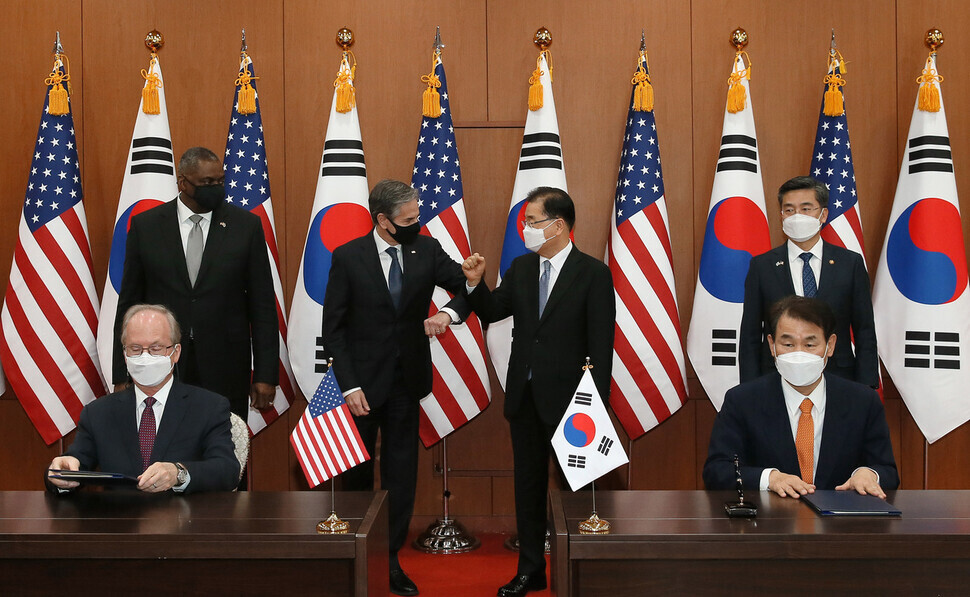hankyoreh
Links to other country sites 다른 나라 사이트 링크
[Editorial] US needs to disclose USFK’s exact garrisoning cost

The US Government Accountability Office (GAO), which reports to Congress, said that stationing US troops in South Korea is in the American interest. That was the conclusion of a recent report that analyzed defense cost-sharing for US Forces Korea (USFK) and US Forces Japan in 2016-2019.
According to the report, reducing the size of USFK would not greatly reduce the total cost to the US since those troops would still need to be redeployed somewhere to carry out their mission. That’s a more balanced cost-benefit analysis of USFK than when former president Donald Trump threatened to withdraw American troops on the grounds that South Korea is getting a “free rider,” paying little for the security provided by the US.
But even the GAO’s report, which was based on figures provided by the US government and the opinions of private sector exports, seems to have undercalculated South Korea’s share of the defense burden. According to the report, the US has paid 15.3 trillion won (US$13.4 billion) over the past four years, while South Korea has paid 6.6 trillion won (US$5.8 billion). That suggests that the US has covered 70% of the cost of USFK, compared to 30% from Korea.
Since the US doesn’t disclose USFK’s exact garrisoning cost, the South Korean government has estimated that it’s picking up about 45% of the tab, based on the funding that Congress appropriates to USFK each year.
When asked about the discrepancy, GAO explained that it didn’t use South Korea’s accounting standards and that it focused on analyzing direct costs, such as cash payments, while excluding indirect costs, such as tax benefits and support for the KATUSA program, which embeds Korean soldiers in US army units.
South Korea’s share of the defense burden varies dramatically depending on what is and is not included. As of 2016, there were 3,600 KATUSA soldiers, referring to members of the South Korean army who are integrated in the USFK chain of command. KATUSA saves USFK US$88.39 million in personnel costs (based on the basic wages for corporals in the US army as of 2016).
When indirect costs (such as discounts or exemptions from taxes and utility bills) are added to direct costs and when the cost of transferring US bases is included, South Korea’s actual defense burden reaches 77.2%, according to a nonprofit group called Solidarity for Peace and Reunification of Korea.
Since 1991, the main issue in South Korea and the US’s negotiations has been finding a reasonable and fair way to share the defense burden. In order to achieve transparency in future cost-sharing negotiations and management, the two sides need to switch from the current “total amount” approach to a “needs-based” approach.
Currently, the total amount is determined first, and then the USFK decides which programs to spend that money on. But under the needs-based approach, the two sides would select programs whose cost would be covered by South Korea. That’s the approach used by US troops in Japan, so there’s no reason it wouldn’t work in Korea, too.
Please direct comments or questions to [english@hani.co.kr]

Editorial・opinion
![[Column] Season 2 of special prosecutor probe may be coming to Korea soon [Column] Season 2 of special prosecutor probe may be coming to Korea soon](https://flexible.img.hani.co.kr/flexible/normal/500/300/imgdb/original/2024/0426/3317141030699447.jpg) [Column] Season 2 of special prosecutor probe may be coming to Korea soon
[Column] Season 2 of special prosecutor probe may be coming to Korea soon![[Column] Park Geun-hye déjà vu in Yoon Suk-yeol [Column] Park Geun-hye déjà vu in Yoon Suk-yeol](https://flexible.img.hani.co.kr/flexible/normal/500/300/imgdb/original/2024/0424/651713945113788.jpg) [Column] Park Geun-hye déjà vu in Yoon Suk-yeol
[Column] Park Geun-hye déjà vu in Yoon Suk-yeol- [Editorial] New weight of N. Korea’s nuclear threats makes dialogue all the more urgent
- [Guest essay] The real reason Korea’s new right wants to dub Rhee a founding father
- [Column] ‘Choson’: Is it time we start referring to N. Korea in its own terms?
- [Editorial] Japan’s rewriting of history with Korea has gone too far
- [Column] The president’s questionable capacity for dialogue
- [Column] Are chaebol firms just pizza pies for families to divvy up as they please?
- [Column] Has Korea, too, crossed the Rubicon on China?
- [Correspondent’s column] In Japan’s alliance with US, echoes of its past alliances with UK
Most viewed articles
- 1[Column] Season 2 of special prosecutor probe may be coming to Korea soon
- 2‘We must say no’: Seoul defense chief on Korean, USFK involvement in hypothetical Taiwan crisis
- 3Is N. Korea threatening to test nukes in response to possible new US-led sanctions body?
- 4Amnesty notes ‘erosion’ of freedom of expression in Korea in annual human rights report
- 5Division commander ordered troops to enter raging flood waters before Marine died, survivor says
- 6N. Korean delegation’s trip to Iran shows how Pyongyang is leveraging ties with Moscow
- 7[Editorial] Korea’s surprise Q1 growth requires objective assessment, not blind fanfare
- 8Is Japan about to snatch control of Line messenger from Korea’s Naver?
- 9No good, very bad game for Korea puts it out of Olympics for first time since 1988
- 10[Reportage] On US campuses, student risk arrest as they call for divestment from Israel